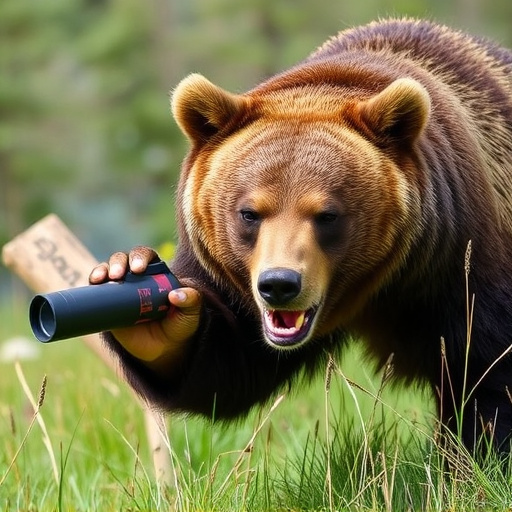Understanding bear behavior and local regulations regarding bear spray is essential for safe camping in areas where bears are present. Bear spray, though effective, faces legal restrictions in many national parks and protected landscapes due to conservation efforts and ecological preservation. It's crucial for campers to check local guidelines before entering these areas, ensuring they follow proper usage techniques and alternative safety strategies like securing food, avoiding known bear paths, and choosing appropriate campsite locations to prevent unexpected encounters.
“Enhancing your camping experience and ensuring safety in bear country is paramount. Bear repellent spray, a controversial yet essential tool, has become a staple for outdoor enthusiasts. This comprehensive guide explores the ins and outs of bear behavior, legal considerations, and effective usage techniques. We delve into when and where bear spray is permitted, dispel myths, and offer alternative safety measures. Understanding these aspects is crucial, especially in regions where bear encounters are common, but remember: knowledge is half the battle. Learn more about navigating the great outdoors responsibly.”
- Understanding Bear Behavior and Their Habitat
- When and Where Is Bear Spray Legal?
- Proper Usage and Application Techniques
- Alternative Measures for Bear Safety While Camping
Understanding Bear Behavior and Their Habitat
Understanding bear behavior is key to knowing when and where bear spray should be used. Bears are wild animals with powerful instincts, primarily seeking food sources and avoiding human confrontation. In many regions, bears have become accustomed to human activities in campsites and wilderness areas, often attracted by food remnants or odours. While they usually prefer to avoid humans, a surprise encounter or the protection of cubs can trigger an aggressive response.
Knowing where bear spray is prohibited is equally important for responsible camping. Some national parks and wilderness reserves have strict rules regarding bear repellent use due to conservation efforts and the delicate ecosystem these areas support. These regulations aim to protect both wildlife and campers, ensuring minimal disruption to natural habitats. Always check local guidelines before venturing into bear country to ensure a safe and enjoyable outdoor experience.
When and Where Is Bear Spray Legal?
Bear spray, also known as bear repellent, is a popular tool for campers and hikers navigating areas with bear populations. However, its legality varies significantly across regions. In many countries, it’s illegal to carry or use bear spray in urban areas, national parks, or other protected landscapes where wildlife encounters are not common. This is primarily due to safety concerns and the potential for accidental misuse.
Where Is Bear Spray Prohibited? Typically, these restrictions apply to densely populated cities, popular tourist destinations, and areas with minimal bear activity. Before heading into the wilderness, campers should always check local regulations. Failure to do so could result in fines or even hinder access to certain trails and camping grounds.
Proper Usage and Application Techniques
Proper usage and application techniques are crucial when it comes to bear repellent spray, ensuring its effectiveness in keeping bears at bay during your camping trips. Begin by checking the product’s instructions, as different brands may have specific guidelines. Typically, you’ll want to spray directly towards the bear’s face and body, aiming for a cloud of mist rather than a direct stream. The spray should be applied from a safe distance, usually around 20-30 feet away, depending on the manufacturer’s recommendations. It’s important to remember that bear spray is not a permanent solution; it only deters bears temporarily, so always keep your distance and follow local guidelines for bear encounters.
When considering where bear spray is prohibited, be mindful of regulations in national parks and wilderness areas. Some regions have strict rules against carrying or using bear spray due to the potential impact on local ecosystems and wildlife behavior. Always check with the relevant authorities or park rangers before packing bear repellent spray for your camping trip.
Alternative Measures for Bear Safety While Camping
When it comes to bear safety while camping, bear repellent spray is a popular and effective choice. However, there are alternative measures campers can take when bear spray isn’t an option or as a supplementary strategy. Understanding local regulations is crucial; some areas may prohibit the use of bear spray due to environmental concerns or specific wildlife management practices. In such cases, knowing the habits and habitats of local bears becomes essential. Campers can avoid known bear paths, secure food properly, and make noise while moving through potentially dense vegetation to deter unexpected encounters.
Additionally, proper campsite setup is vital. Choosing a site away from thick brush and trees can reduce the risk of surprise attacks. Setting up camp in an open area or on higher ground offers better visibility and easier escape routes if needed. These non-spray methods, combined with awareness of local wildlife guidelines, provide a more comprehensive approach to bear safety, ensuring a memorable camping experience without relying solely on bear repellent spray.
Bear repellent spray is an essential tool for campers navigating areas with bear habitats, but it’s crucial to understand local regulations. While bear spray is legal in many outdoor recreational spaces, certain regions have strict rules regarding its use and availability. Always check local guidelines before heading out, as prohibited areas exist for a reason. Proper usage and application techniques are vital to ensure effectiveness, and considering alternative safety measures can further enhance your camping experience in bear country. Remember, prevention and understanding bear behavior are key to a safe outdoor adventure.
